The Best Image?
This post features five of my favorite shorebird images from yesterday morning at JBay. Which is your favorite? Why? I like them all, but have two or three favorites. I will be publishing what I consider the three very best images from the session here soon.
What’s Up?
I’ve been photographing at the East Pond at Jamaica Bay Wildlife Refuge for 39 years. Saturday morning, enjoyed with client/friend Muhammad Arif, was one of — if not the, very best mornings ever. We were in the perfect spot and the birds showed up almost before we were ready. The birds were very close. After a bit, we needed to move back a bit to be able to focus. The tally for the morning: created 2479 images, kept 120. That 4.8% keeper rate will go down considerably after a second edit.
Afterwards, it was nice seeing some old friends on the Shorebird Festival walk. Learning of the recent deaths and life-threatening illnesses of others? Not so much. As we age, we get to face our own mortality head on.
Today is Sunday 14 August. I headed to Nickerson Beach very early, had some decent chances, and was back in the car finishing this post at 8:15am. Wherever you are, and whatever you are doing, I hope that you too have a great day. This blog post took about 90 minutes to prepare and makes one hundred forty-three days in a row with a new one.
So far, nine folks have been in touch about joining me at either Nickerson or JBWR in the coming weeks for an In-the-Field session or two. The first window for doing shorebirds at the East Pond at Jamaica Bay Wildlife Refuge is closing now, the second window is from 24-26 August. See the additional details below.
Please remember to use the B&H and Amazon links that are found on most blog pages and to use the BIRDSASART discount code at checkout when purchasing your new gear from Bedfords to get 3% back on your credit card and enjoy free second-day air FedEx. Please, also, consider joining a BAA IPT. You will be amazed at how much you will learn!
|
|
|
Clockwise from the upper left corner back around to the center: Wilson’s Phalarope, JBWR; just fledged Common Tern, Nickerson; Black Skimmer, adult skimming, Nickerson; Black Skimmer killing tiny skimmer chick, Nickerson; American Oystercatcher foraging at sunrise, Nickerson; Common Tern chick swallowing baby bluefish, Nickerson; Short-billed Dowitcher, juvenile, double overhead wing stretch, JBWR; Black Skimmers, predawn flock blur, Nickerson; Black Skimmer, 10-day old chick, Nickerson. Click on the card to view a larger version. Nickerson Beach/East Pond JBWR composite |
Nickerson Beach/East Pond at Jamaica Bay (JBWR) In-the Field Workshops
Both Nickerson Beach and the East Pond at JBWR offer some of the best midsummer bird photography on the planet. Hundreds of pairs or Black Skimmers and Common Terns along with more than a dozen pairs of American Oystercatchers breed at Nickerson each season so there are lots of chicks of all sizes and handsome fledged young to photograph. Provided that the water levels are low, hundreds of young shorebirds in their handsome fresh juvenile plumages stop by the pond each August on their way south.
Nickerson often reveals nature at it rawest, most basic level. Most days we get to photograph all sorts of dramatic behaviors ranging from skimmers and terns fishing and feeding (and tending) their you. There are often chances to shoot a variety of predatory encounters — gulls eating large skimmer chicks, skimmers eating skimmer babies, and Peregrine Falcons hunting. And rarely, if we are lucky, Peregrine Falcons catching! Consider joining me to learn a ton both about bird photography and the birds.
I am taking the Auto Train north on 31 July and will happily spend all of August on Long Island. I head south on 31 August and should be back home on 1 September (barring anything unforeseen). I am offering In-the-Field sessions at both Nickerson Beach and the East Pond at Jamaica Bay Wildlife Refuge. If you are interested, please get in touch via e-mail or text me at 863-221-2372.
Whether you are a local or would like to fly in for several days of instruction — a sort of private, or small group. — at worst, IPT, LMK via e-mail so that we can work on a schedule that could possibly include both Nickerson and Jamaica Bay.
Follow me on Instagram here. I am trying to feature both new and old images, especially images that have not appeared recently on the blog.
BIRDS AS ART Image Optimization Service (BAA IOS)
Send a PayPal for $62.00 to birdsasart@verizon.net or call Jim at 863-692-0906 and put $62.00 on your credit card. Pick one of your best images and upload the raw file using a large file sending service like Hightail or DropBox and then send me the link via e-mail. I will download and save your raw file, evaluate the exposure and sharpness, and optimize the image as if it were my own after converting the raw file in Adobe Camera Raw. Best of all, I will make a screen recording of the entire process and send you a link to the video to download, save and study.
Induro GIT 304L Price Drop
Amazingly, we have two, brand-new-in-the-box Induro GIT 304L tripods in stock. They are $699.00 each (were $799.00) and the price now includes the insured ground shipping to the lower 48 states. Weekday phone orders only: 863-692-0906. Order yours here while they last.
|
|
|
This image was created on 13 August 2022 at the East Pond at Jamaica Bay Wildlife Refuge in Queens, NY. While seated on damp mud and working off the tilted rear screen, I used the flattened, no-longer available except from BIRDS AS ART, Induro GIT 304L tripod/Levered-Clamp FlexShooter Pro-mounted Sony FE 600mm f/4 GM OSS lens and The One, the Sony Alpha 1 Mirrorless digital camera. ISO 1600. Exposure was determined via Zebras with ISO on the rear dial: 1/320 sec. at f/4 (wide open). AWB at 6:22:52am on a clear morning with a large cloud in front of the sun. Tracking: Zone/AF-C was active at the moment of exposure and performed perfectly. Be sure to click on the image to enjoy the larger version. Image #1: Semipalmated Sandpiper juvenile in no light situation |
Off to a Great Start
There was a big-ass cloud in front of the sun as we walked out onto the South Flats. I knew exactly where we needed to be. We got in position and sat down on the wet mud — Muhammad had brought a yoga mat to sit on. Before I had finished leveling the silver ball of the Levered-Clamp FlexShooter Pro, a handsome young semi-sand landed point-blank right in front of us.
The Huge Sony Advantage
When the tiny sandpiper landed almost too close to me in no-light conditions, I chose a shutter speed — 1/320 sec., that I thought would make a sharp image if the bird held still for a moment. Working wide open at f/4 in the low light, I raised the ISO using the rear dial until I had lots of Zebras on the water. The result: a perfect exposure in a difficult situation. As the bird was walking most of the time, I made only a single sharp image out of a dozen. But I got the exposure right!
|
|
|
This image was also created on 13 August 2022 at the East Pond at Jamaica Bay Wildlife Refuge in Queens, NY. Again, while seated on damp mud and working off the tilted rear monitor, I used the flattened, no-longer available except from BIRDS AS ART Induro GIT 304L tripod/Levered-Clamp FlexShooter Pro-mounted Sony FE 600mm f/4 GM OSS lens and The One, the Sony Alpha 1 Mirrorless digital camera. ISO 1000. Exposure was determined via Zebras with ISO on the rear dial: 1/500 sec. at f/4 (wide open). AWB at 6:27:08am just as the sun cleared the large cloud in front of the sun. Tracking: Zone/AF-C was active at the moment of exposure and performed perfectly. Be sure to click on the image to enjoy the larger version. Image #2: Lesser Yellowlegs juvenile in golden early morning light |
Gorgeous Yellow Light on the Phragmites
Once the sun cleared the big cloud, it was just a matter of getting a bird in halfway decent position. This young yellowlegs landed to our left in the glorious color. The upper background is (invasive) phragmites. Overall, this species is a big negative. It grows as a dense monoculture that crowds out dozens of various native plant species thus several reducing species diversity of both plants and animals. I just might try working off a Panning Ground Pod next time and going for the all-yellow background.
The Huge Sony Advantage
In the golden light, I again chose a shutter speed — this time 1/500 sec., that I knew would make a sharp image if the bird held still for a moment. Again, working wide open (without a teleconverter) at f/4 in the low light, I raised the ISO using the rear dial until I had some Zebras on the water. The result: another perfect exposure in a difficult situation.
I coached Muhammad as to shutter speed and ISO in each situation as I had the huge advantage of having Zebras live in the viewfinder.
|
|
|
This image was also created on 13 August 2022 at the East Pond at Jamaica Bay Wildlife Refuge in Queens, NY. While seated on damp mud and working off the tilted rear monitor, I used the flattened, no-longer available except from BIRDS AS ART, Induro GIT 304L tripod/Levered-Clamp FlexShooter Pro-mounted Sony FE 600mm f/4 GM OSS lens with the Sony FE 1.4x Teleconverter (at 840mm) with The One, the Sony a1 Mirrorless Camera. The exposure was determined via Zebras with ISO on the Thumb Wheel. ISO 640: 1/1600 sec. at f/6.3. AWB at 8:53:14am on a sunny morning. Tracking: Zone/AF-C with Bird Eye/Face Detection performed perfectly all morning long by accurately tracking the birds’ eyes (as long as the birds were not moving quickly, filling the whole frame, or turning their heads away). Image #3: Semipalmated Sandpiper juvenile facing the camera |
Facing
It is difficult to pull off nice images of shorebirds facing directly at you. AF does not always perform superbly as it did here with Image #3 because the system does not really have a good look at the subject’s eye. I like the good look at the blob-tipped bill that denotes Semipalmated Sandpiper. Least Sandpipers are browner or redder and have fine-tipped bills. Western Sandpipers have longer bills that are deeper (thicker from top to bottom) at the base and have flattened slighted decurved bill tips. I like the raised leg, the slight sidelight, and the sharpness of the bird’s face and head. Note the light yellowish/green legs that might be confused with the yellow legs Least Sandpiper.
The Huge Sony Advantage
In the full sun, I chose a shutter speed that could freeze the foraging birds: 1/1600 sec. Now working wide-open at f/5.6 with the 1.4X teleconverter in place, I raised the ISO using the rear dial until I had some faint Zebras on sunlit whites on the bird’s breast. The result: another perfect exposure in a difficult situation.
|
|
|
This image was also created on 13 August 2022 at the East Pond at Jamaica Bay Wildlife Refuge in Queens, NY. While seated on damp mud and working off the tilted rear monitor, I used the flattened, no-longer available except from BIRDS AS ART, Induro GIT 304L tripod/Levered-Clamp FlexShooter Pro-mounted Sony FE 600mm f/4 GM OSS lens with the Sony FE 1.4x Teleconverter (at 840mm) with The One, the Sony a1 Mirrorless Camera. The exposure was determined via Zebras with ISO on the Thumb Wheel. ISO 640: 1/1600 sec. at f/6.3. AWB at 7:43:06am on a sunny morning. Tracking: Zone/AF-C with Bird Eye/Face Detection performed perfectly all morning long by accurately tracking the birds’ eyes (as long as the birds were not moving quickly, filling the whole frame, or turning their heads away). Image #4: Lesser Yellowlegs juvenile flicking wings |
Aggressiveness and Serendipity Pay Off
I had a perfect portrait of this bird standing still lined up with the AF point right on the bird’s eye, a nice low perspective, a fast enough shutter speed, and the guaranteed correct exposure. Rather than making 3 or 4 images, I decided to hold the shutter button down until the bird did something. This strategy was rewarded when another shorebird flew by overhead and my subject bird flicked its wings as I fired continuously. Getting an image this good required some luck, but had I not been set up perfectly, all would have been for naught.
The Huge Sony Advantage
Again, working in full sun, I chose 1/1600 sec. to freeze the potential action and raised the ISO using the rear dial until I had some faint Zebras on the sides of the breast and the flanks of this young yellowlegs. The result: another perfect exposure in a difficult situation.
|
|
|
This image was also created on 13 August 2022 at the East Pond at Jamaica Bay Wildlife Refuge in Queens, NY. Again, , while seated on damp mud and working off the tilted rear monitor, I used the flattened, no-longer available except from BIRDS AS ART, Induro GIT 304L tripod/Levered-Clamp FlexShooter Pro-mounted Sony FE 600mm f/4 GM OSS lens with the Sony FE 1.4x Teleconverter (at 840mm) with The One, the Sony a1 Mirrorless Camera. The exposure was determined via Zebras with ISO on the Thumb Wheel. ISO 800: 1/1000 sec. at f/8. AWB at 8:13:25am on a sunny morning. Tracking: Zone/AF-C with Bird Eye/Face Detection performed perfectly all morning long by accurately tracking the birds’ eyes (as long as the birds were not moving quickly, filling the whole frame, or turning their heads away). Image #5: Marbled Godwit vertical |
Verticals from Horizontal Originals
I had this bird on the left side of the frame looking right. When it turned its head elegantly to my left, I fired off two frames. With the 51,000,000 pixels of a sharp a1 ARW file, the crop to a vertical was the obvious choice.
The Huge Sony Advantage
Working in full sun, but well-off sun angle, I dropped down to 1/1000 sec. for the foraging godwit. Then I adjusted the ISO until I had faint Zebras on the neck of the Marbled Godwit. The result, and I hope that you are not bored yet: another perfect exposure in a difficult situation.
The Lesson: in rapidly changing light, folks using Sony gear with Zebras set properly have a huge advantage over folks using systems that do not offer Zebras in the viewfinder with stills.
Typos
With all blog posts, feel free to e-mail or to leave a comment regarding any typos or errors.

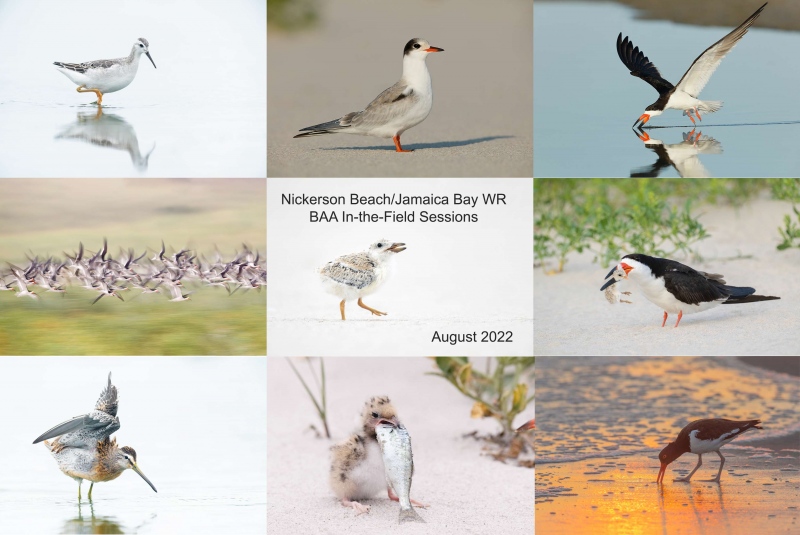
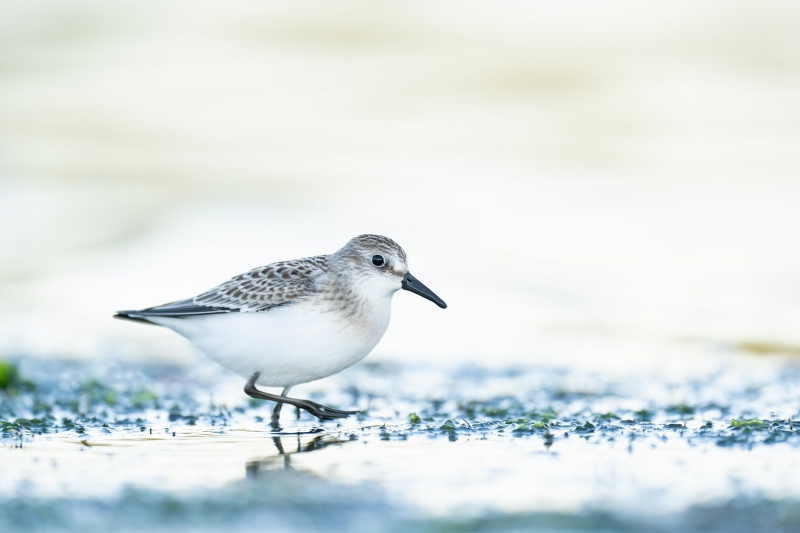
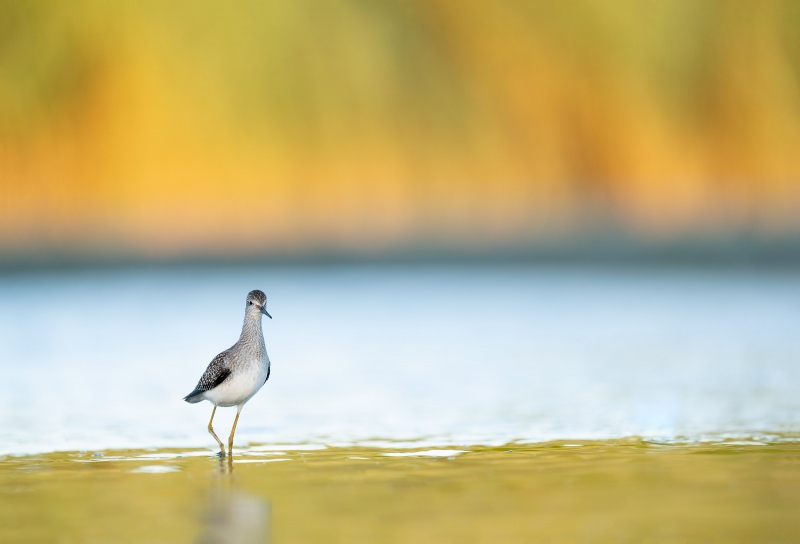
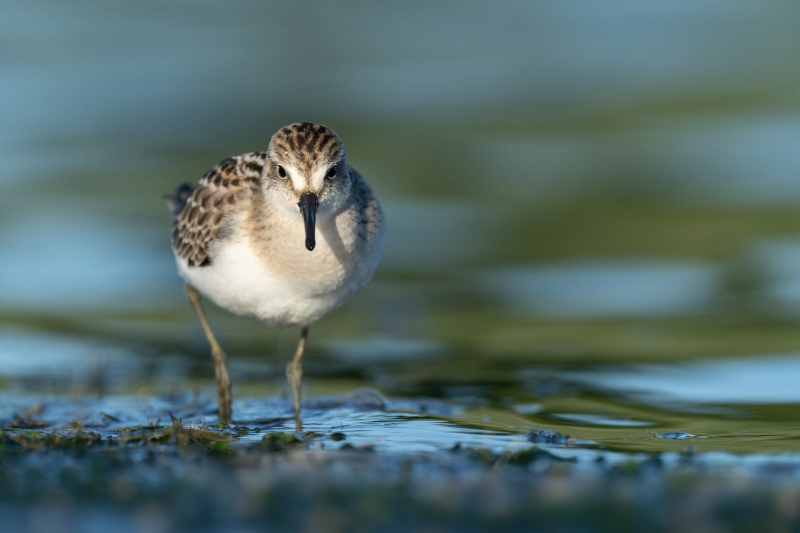
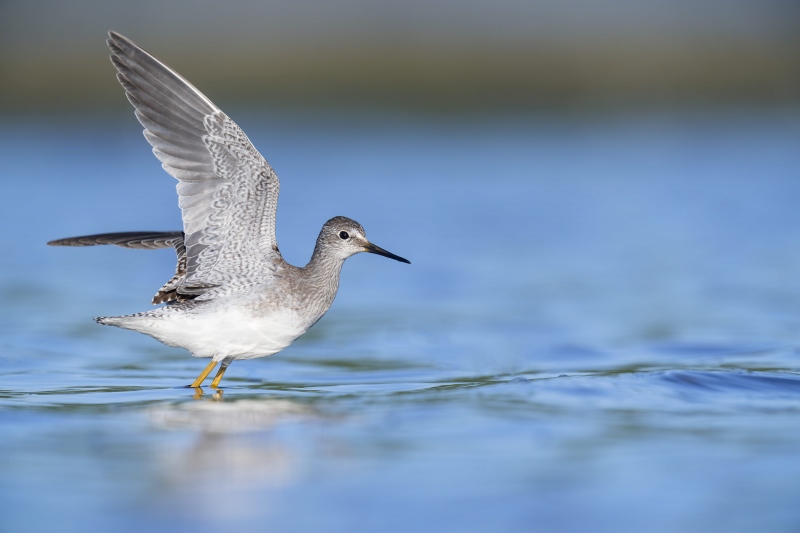
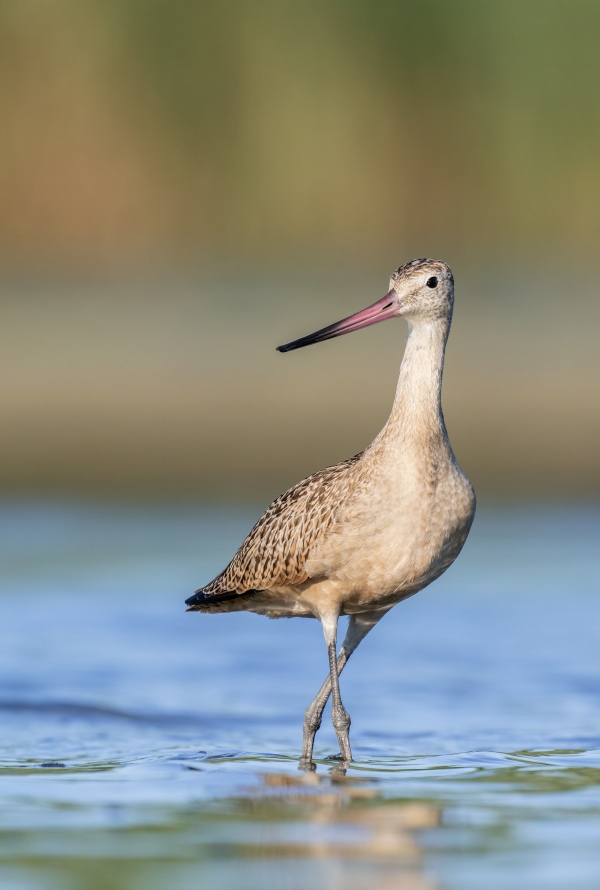













My favourite is image #5. Like the lighting, pose, background, foreground and the orientation of the photo.
I am going with flow here (to some degree)
I like #5 …. bird large in the frame, awesome light, the elegant pose that also allows a nice sharp image from bill tip to tail, exposure and sharpness techniques top notch.
Having said all that, I think you could improve it by making some changes to the background:
1. There is a faint dark horizontal band that cuts through the bird’s head. Probably where the weeds meet the far shore. I would lighten this.
2. There are two vertical dark bands in the blurred out vegetation. I would lighten those too.
That’s my 2 cents 🙂
I really like #5 because of the opposing body positions and the soft green backgound that adds
dimension with nice DOF .
What James R Saxon said.
Thank you Dr. Fish.
with love, a
Difficult to pick, but #5. Godwit’s size in frame, pose, sharpness with beautifully blurred foreground/background, etc.etc. Wow!
Thanks, Doc. With love, artie
When I got to #4 I thought I found my favorite — I loved the soft colors and the action in this image of a lesser yellowlegs. But, then, I saw #5 and was blown away. I loved the graceful stance of the godwit and the gorgeous soft background colors.
Thanks, Pat. Everybody loves godwits especially me 🙂
with love, artie
My favorite is No. 3, due to Sandpiper’s straight into the lens look, the shallow depth of field, color reflected from the sky and background into the water, and the green plants protruding from the water. Closely following is No.1, also a Sandpiper, because of the muted white background, and the even more pronounced vegetation breaking the surface of the water, adds just the right amount of color. Hmm, maybe I like No. 1 better than No. 4.
No. 5 is also a very graceful, (dare I say thoughtful looking), pose.
Thanks, Nancy. Did your metal prints arrive yet? Thanks again for your order.
with love, artie
No, Artie, the metal prints haven’t been delivered yet. I rather expect them around midweek; I’ll be certain to let you know when they are received and how they look on metal. nf
Another rewarding morning! Love the color palette of #1 so that’s my choice
Thanks, Pugs. Pretty subtle color palette 🙂
with love, artie
I definitely envy Sony users for zebras, and the 200-600 lens.
Thanks, Andy. That is the point of today’s blog post. Muhammad struggled getting the right exposures as the light changed. The 2-6 is a great lens, but everything here was made with the 600mm f/4. with love, artie
#5 is my favorite, with the vertical format, crossed legs and head turn. Next is #4 with the upturned wing, small wave at the feet and the bird moving into the frame. #2 that has the bird in the middle third of the image. The different colors of the water and background divide the image into thirds with the bird sitting in the intersection of the rule of thirds. #3 with that stare. #1 shows motion with one of the feet raised but the color of the bird seems to blend into the bright background. I would be happy to have all these images in my portfolio. Thanks for sharing and continue to enjoy your trip.
Thanks, Jim. I could not disagree with you at all.
with love, artie